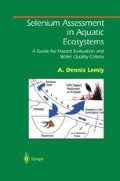Abstract
One of the most extensive and prolonged cases of selenium poisoning in freshwater fish occurred at Belews Lake, NC in the United States (Fig. 3.1). Belews Lake was contaminated by selenium in wastewater released from a coal-fired electric generating facility. From 1974 to 1986, water was withdrawn from the lake and mixed with bottom ash from the coal burners and fly ash collected by electrostatic precipitators. This slurry was pumped from the power plant and discharged into a 142 ha ash basin, where suspended solids were collected by gravitational settling. Selenium-laden (150–200 μg Se/L) return flows from the ash basin entered the west side of Belews Lake through an ash sluice water canal (Lemly 1985).
Access this chapter
Tax calculation will be finalised at checkout
Purchases are for personal use only
Preview
Unable to display preview. Download preview PDF.
References
Cleveland, L., E. E. Little, D. R. Buckler, and R. H. Wiedmeyer. 1993. Toxicity and bioaccumulation of waterborne and dietary selenium in juvenile bluegill (Lepomis macrochirus). Aquatic Toxicology 27:265–280.
Coyle, J. J., D. R. Buckler, C. G. Ingersoll, J. F. Fairchild, and T. W. May, 1993. Effects of dietary selenium on the reproductive success of bluegills (Lepomis macrochirus). Environmental Toxicology and Chemistry 12:551–565.
Cumbie, P. M., and S. L. Van Horn. 1978. Selenium accumulation associated with fish mortality and reproductive failure. Proceedings of the Annual Conference of the Southeastern Association of Fish and Wildlife Agencies 32:612–624.
Diplock, A. T., and W. G. Hoekstra. 1976. Metabolic aspects of selenium action and toxicity. Critical Reviews in Toxicology 5:271–329.
Ellis, M. M., H. L. Motley, M. D. Ellis, and R. O. Jones. 1937. Selenium poisoning in fishes. Proceedings of the Society for Experimental Biology and Medicine 36:519–522.
EPA (U.S. Environmental Protection Agency). 1987. Ambient water quality criteria for selenium—1987. Washington, DC. USEPA, Office of Water Regulations and Standards. EPA-440/5-87-006.
Ganther, H. E. 1974. Biochemistry of selenium. In Selenium, eds. R. A. Zingaro and W. C. Cooper, 546–614. New York: Van Nostrand Reinhold Co.
Hocutt, C. H., and J. R. Stauffer, Jr. 1980. Biological Monitoring of Fish. Lexington: D.C. Heath.
Lemly, A. D., and G. W. Esch. 1984. Effects of the trematode Uvulifer ambloplitis on juvenile bluegill sunfish, Lepomis macrochirus: Ecological implications. Journal of Parasitology 70:475–492.
Lemly, A. D. 1985. Toxicology of selenium in a freshwater reservoir: Implications for environmental hazard evaluation and safety. Ecotoxicology and Environmental Safety 10:314–338.
Lemly, A. D. 1993a. Teratogenic effects of selenium in natural populations of freshwater fish. Ecotoxicology and Environmental Safety 26:181–204.
Lemly, A. D. 1993b. Metabolic stress during winter increases the toxicity of selenium to fish. Aquatic Toxicology 27:133–158.
Lemly, A. D. 1997. Ecosystem recovery following selenium contamination in a freshwater reservoir. Ecotoxicology and Environmental Safety 36:275–281.
NCDNRCD (North Carolina Department of Natural Resources and Community Development). 1986. North Carolina water quality standards documentation: The freshwater chemistry and toxicity of selenium with an emphasis on its effects in North Carolina. Raleigh, NC. NCDNRCD. Report No. 86-02.
Oliver, J. D., G. F. Holeton, and K. E. Chua. 1979. Overwinter mortality of finger-ling smallmouth bass in relation to size, relative energy stores, and environmental temperature. Transactions of the American Fisheries Society 108:130–136.
O’Toole, D., and M. F. Raisbeck. 1998. Magic numbers, elusive lesions: Comparative pathology and toxicology of selenosis in waterfowl and mammalian species. In Environmental Chemistry of Selenium, eds. W T. Frankenberger, Jr., and R. A. Engberg, 355–395. New York: Marcel Dekker.
Rand, G. M., and S. R. Petrocelli. 1985. Fundamentals of Aquatic Toxicology. New York: Hemisphere Publishing.
Reddy, C. C, and E. J. Massaro. 1983. Biochemistry of selenium: An overview. Fundamental and Applied Toxicology 3:431–436.
Ribelin, W. E., and G. Migaki. 1975. The Pathology of Fishes. Madison, WI: University of Wisconsin Press.
Shearer, T. R., L. L. David, and R. S. Anderson. 1987. Selenite cataract: A review. Current Eye Research 6:289–300.
Sorensen, E. M. B., P. M. Cumbie, T. L. Bauer, J. S. Bell, and C. W. Harlan. 1984. Histopathological, hematological, condition-factor, and organ weight changes associated with selenium accumulation in fish from Belews Lake, North Carolina. Archives of Environmental Contamination and Toxicology 13:153–162.
Sorensen, E. M. B. 1986. The effects of selenium on freshwater teleosts. In Reviews in Environmental Toxicology 2, ed. E. Hodgson, 59–116. New York: Elsevier.
Stadtman, T. C. 1974. Selenium biochemistry. Science 183:915–922.
Sunde, R. A. 1984. The biochemistry of selenoproteins. Journal of the American Organic Chemistry Society 61:1891–1900.
Thompson, J. M., E. P. Bergersen, C. A. Carlson, and L. R. Kaeding. 1991. Role of size, condition, and lipid content in the overwinter survival of age-0 Colorado squawfish. Transactions of the American Fisheries Society 120:346–353.
Toneys, M. L., and D. W. Coble. 1980. Mortality, hematocrit, osmolality, electrolyte regulation, and fat depletion of young-of-the-year freshwater fishes under simulated winter conditions. Canadian Journal of Fisheries and Aquatic Sciences 37: 25–32.
Author information
Authors and Affiliations
Rights and permissions
Copyright information
© 2002 Springer Science+Business Media New York
About this chapter
Cite this chapter
Lemly, A.D. (2002). Toxic Effects of Selenium in Fish. In: Selenium Assessment in Aquatic Ecosystems. Springer Series on Environmental Management. Springer, New York, NY. https://doi.org/10.1007/978-1-4613-0073-1_3
Download citation
DOI: https://doi.org/10.1007/978-1-4613-0073-1_3
Publisher Name: Springer, New York, NY
Print ISBN: 978-1-4612-6549-8
Online ISBN: 978-1-4613-0073-1
eBook Packages: Springer Book Archive

